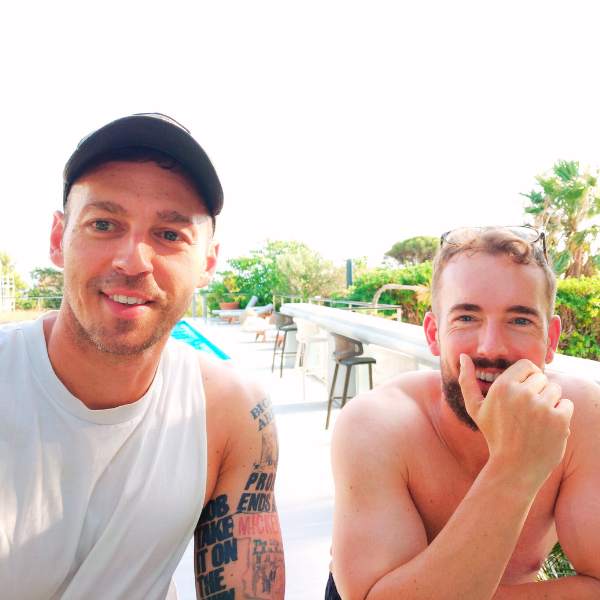TLDR: Last year my best mate and I answered the bucket list roadtrip call of the Mongol Rally and found ourselves hurtling towards what was once called Yugoslavia. Now, back in the UK, I thought I’d sit down and share with you our 3 week Balkans itinerary, including two routes to copy. One for beach fans and another for city types. Hit the link below to take you straight to the itineraries.
Jump to: The itinerary | When to go | Safety | Budget | Getting around | Best stays
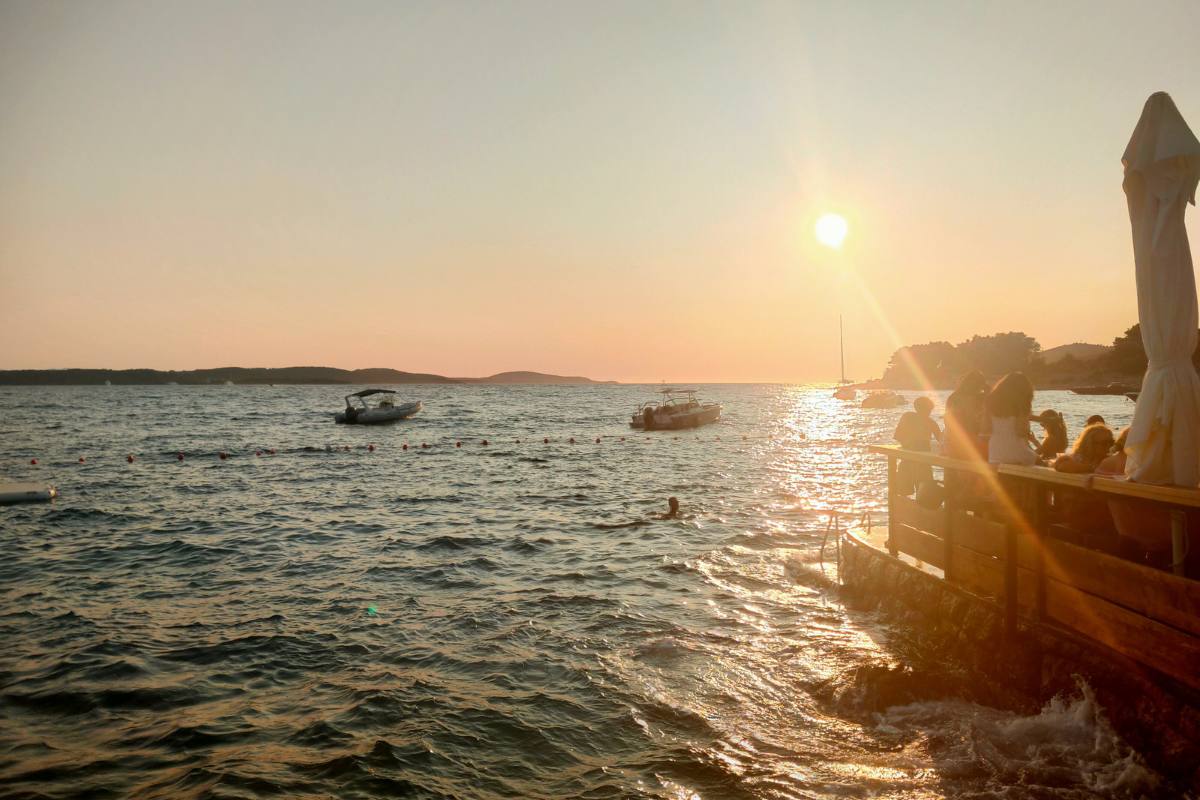
What to know before you go

Ave temp
10°C Oct – Feb
25°C March – Sept

Languages spoken
Bosnian, Croatian, Serbian & some English

Money needed
Euros, Serbian Dinar
ALB Lek, MKD Denar, BAM KM

Visa info
90-day visa-free
for CANZUK/EU/US
If you’re heading for the coast and to be fair even if you’re not, you will get the best out of the Balkans in the warmer months. This means heading this way between May and September.
Our Balkans roadtrip had us driving around in July, and to be fair, if you’re using an old car with no AC like us – then I’d suggest doing it a little before the road temperatures reach the mid 40s.
Dear lord, those are hot days.
If you do skip the peak summer months, you will avoid some of the crowds in the busier spots too. While you want lively if you’re off to party in Hvar, you are going to struggle to enjoy places like Dubrovnik which get mobbed.
So having thought about it now, writing this, I’d say May-June and Sept to Oct will be the best compromise. Accommodation prices will pare back a touch and there will still be both warmth and other people around to make sure the bars and nightlife areas don’t feel deserted. If you’re coming for the ski season, which Maribor up in North Serbia offers, ignore all of this and come in the winter. You’ll hate us if you think you can hit the piste in July!
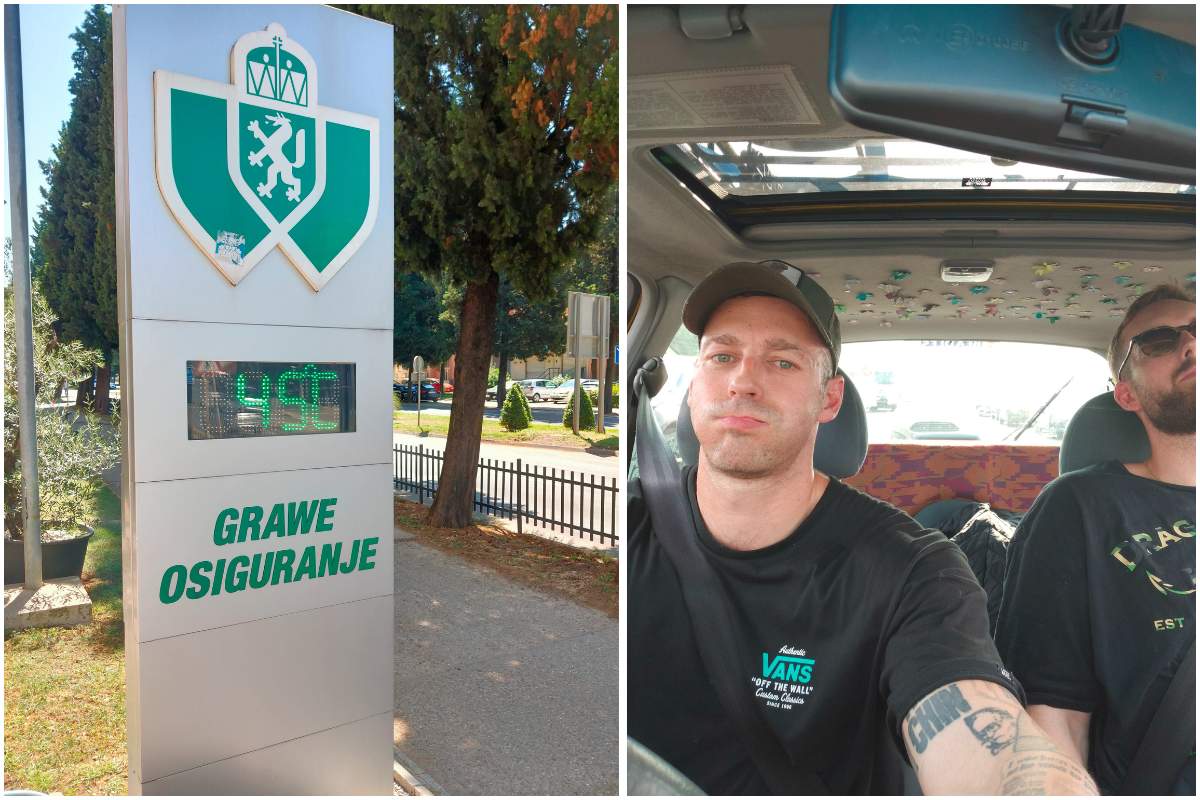
Balkans roadtrippers will be pleased to know the roads are reasonably sound. There are some scarier passages up around Bosnia which doesn’t seem to have invested in it’s road network the same way Croatia has. Albania is hit and miss and Serbia near the big cities is not entirely terrible. Imagine a former soviet country with minimal investment in fixing potholes and windy routes around mountains that have limited barriers and you’re picturing it perfectly.
In truth our scariest moment was almost being run off the road by a very short Chinese lady who couldn’t really see above the steering wheel let alone understand how to look before pulling out. Other than that – it’s really quite scenic.
Rail is a bit disjointed. You can’t get a train from Zagreb, Dubrovnik or Split for example to Belgrade, nor can you get there by train from Podgorica. You’ll find though that Flixbus works pretty well in this part of the world and failing that, you could fly from local airports. Might get a bit pricey though. So, stick with the bus if you don’t have your own wheels.
Buses however are really affordable and you can get from Zagreb in Croatia to Belgrade in Serbia for about £25 or $30. I use that as an example. Podgorica in Montenegro to Belgrade isn’t much different in price either. (Source Omio 2025)
Incidentally there used to more rail connections but they were suspended in 2021 during Covid and while there is talk of restoring them, that hasn’t come to pass yet. I assume it will happen as it will do Serbia, Bosnia and Montenegro wonders in terms of tourism boosts.
In truth to do it all, including covering Slovenia, Bosnia, Serbia, Montenegro, Albania, North Macedonia, Kosovo and Croatia, not really no. That said, you CAN have an amazing time with 3 weeks in the Balkans and if you don’t do what we did which was continually extend our time in Hvar, you can see a lot.
Also one caveat on our own trip, we were driving a 25 year old 1 litre Nissan Micra with no air con and 6 horsepower, with a roofrack holding spare tyres and a jerry can. We weren’t exactly optimised for speed.
Had we been in a car that could do 70mph without sounding like it was about to explode, we could have covered more distance.
But in our 3 weeks we focused on hitting the beaches AND checking out some of the historic Soviet and Balkan War cities – and I think we did a pretty good job of that.
So if you have 3 weeks in the Balkans, I and use our itinerary as a guideline, you’re going to be pretty satisfied.

There is a famous saying about the former Yugoslavia by it’s military leader Tito:
I am the leader of one country which has two alphabets, three languages, four religions, five nationalities, six republics, surrounded by seven neighbours, a country in which live eight ethnic minorities.”
So a Berlitz phrase guide, probably won’t get you very far as you’ll need several!
So – what about language today? Well many of the languages are closely aligned to types of Slavic, and are more like dialects of one another, but your Spanish, French and even English skills may at times not be as useful as you’d like. It really depends where you are in the Balkans. In Croatia you’ll find English more readily spoken, while in Serbia, you’d possibly get on better with Russian. Albania – forget it 🙂
Currency wise, Croatia, Slovenia and Kosovo use the Euro, but the other nations use their own domestic currencies. We took a load of Euros with us, but we couldn’t use them in non Euro nations in the way we thought we may be able to. In the end we found using card was more than sufficient.
These days I’m loathed to change up to more niche currencies as most places take card and you’ll only end up with a lot of expensive souvenirs you’re never likely to use again.
Get yourself a Revolut card and then you can get great exchange rates and easily block the card if you lose it.

If you want some help on how to pack for a roadtrip around the Balkans from a clothing perspective, I’ll add a link below. You can learn about what is known as the 54321 method.
But in short, appreciate that it’s a warm part of the world, so take some strong SPF, shades and hat as standard. But also bars and nightlife tend to be a little smarter in some regions so have that in mind. If you’re in the Balkans in the summer, it does get hot which meant I was very thankful for linen fabric clothing and the water is insanely inviting – so take swim gear.
Given that we did this as a roadtrip, we had a little more space than others may do. That meant we carried an empty jerry can and spare tyres as soe of the roads can be quite gravelly and punctures aren’t unheard of. Also the roads get warm, so there are other risks to your tyres with overheating too.
If you break down you won’t have easy access to roadside repair, which means you will want to pack a few key tools, like spanners/ratchets etc and something I don’t leave home without – a portable jump starter pack. Absolute life saver.
If your car breaks down you will need a power source and you don’t want to drain the battery. A decent portable jump starter pack doubles as an amazing power bank too.
Not a lot of money for a lot of reassurance.
All in all, we found ourselves living in t-shirts, birkenstocks and shorts most of the time – the only time we really needed layers was when north of Serbia in the ski resort of Zlatibor. While it wasn’t winter, it did cool down at night, and I was pleased to have brought a long a lightweight hoody.
Roadtrip essentials
- Ratchet Straps – These double as tow ropes but also tie things down on bumpy roads
- Big Jerry Can – You never know if you’ll need extra fuel for a long ride without gas stations.
- EU Driving Kit – This is a legal requirement in EU nations and includes things like a first aid kit, high vis jacket and reflector sign. You can buy them as a pack on Amazon
- Spare Tyres – Don’t expect to find spares out in the sticks easily – or someone to replace them
- Roof Tray – These let you store jerry cans and tyres outside the car increasing your comfort inside it.
- Military Ration Packs (MRE) – These were a life saver when stuck in long traffic jams or when no conveniences could be found
- KFS Set – Never hurts to have your own wooden sporks or cutlery set
- Portable Jump Starter Pack – Doubles as a power bank and can get a flat battery going again
- Puncture Repair Tools – Needs no explanation
- Cable Ties – You will be amazed how many things these keep fixed to your car…like broken wing mirrors

To get a deeper idea of what to take on an extended trip around the Balkans, check out that guide I mentioned, linked below:

Travel Safety in the Balkans
While there are still pockets of tension across the Balkans, particularly around Kosovo/Serbia and Bosnia/Republika Srpska, much of the rest of the region is low in violent crime and is safe for tourists. However, legacy problems from the wars remain, in the form of landmines, unexploded munitions and territorial political disputes, so exercise caution in rural regions if you’re off the beaten path.
As much of the region is in the EU or seeks to join it, tensions have softened and the likelihood of conflict suddenly breaking out now are considered unlikely due to a younger population with no appetite for war.
For up-to-date travel safety warnings in the main remaining area of less stability, check out the UK’s Foreign and Commonwealth Office travel advice site covering Serbia: Serbian Travel Safety Advice
Our own 3 week Balkan roadtrip
DISCLAIMER: This post might have links to travel services and products that we enjoy. We might make a commission from it at no extra cost to you.
I work in travel and that means I spend a lot of time looking at things that tempt me away from my desk and have me dreaming of hitting the road. One of those things I’d always wanted to do was the Mongol Rally. This is an escapade of stupidity that sends you and a mate around the world in a terribly prepared car.
The lockdowns had stifled that dream; so as soon as spaces came available, I found myself a car and roped in a buddy to do it with me.
We spent weeks cutting across Europe but 3 weeks were devoted to driving around the Balkans and seeing as much as we could in that time. Our goal was to get down to Capadoccia in Turkey and see the hot air balloons but time flew by and we had to hightail it back to the UK.
The 3 week Balkan itinerary I am going to share below, works whether you are roadtripping or not. In truth, had we bussed our way around, we may have covered more ground. So, make of that what you will.
Would I change anything in hindsight? Hell, no!
Distance Covered: 2000 km (approx)
Crashes: 0.5
Favourite Place: Hvar
Favourite City: Belgrade
Favourite Activity: Horse-riding in Lake Skadar
Favourite Event: Thievery Corporation live in Pula
Surprise Gem: Podgorica
Why? Podorica is a great little city; cheap to stay in, very accessible and has everything, including some great gyms.

Tip for roadtrippers: Get travel insurance
Fingers crossed nothing bad happens, but if you’re driving through the Balkans, you’ve got some narrow roads, big hills and surfaces that don’t exactly resemble Broadway. This means, punctures, prangs and being stranded isn’t out of the ordinary.
As well as your car insurance and a boot full of spares, don’t skimp on something that is less money than a pizza but could make a life changing difference, and that’s travel insurance. Ekta is one choice, they help support the blog, but there are others available too. Just, make sure you have some protection.
Try this: EKTA Insurance
The Itinery: 3 Weeks Of Balkan Beaches & Grads
Okay here goes, this first itinerary for the Balkans gave us a balance of urban and beachlife. For you, I think it’s a great all rounder to consider. It means you could jump into the warm blue Adriatic waters, as well as check out the brutalist meets bohemia of cities like Belgrade.
In the roadtrip routemap below, you can see a red pin around Shkoder. I’ve added this, as it was where we deviated from the route slightly to go horseriding in Albania, but my software wouldn’t let me add another stop on the image. If you can ride a horse, I recommend doing that there.
NB: A grad means city in Serbo-Croat; I was just being a bit extra with the title.
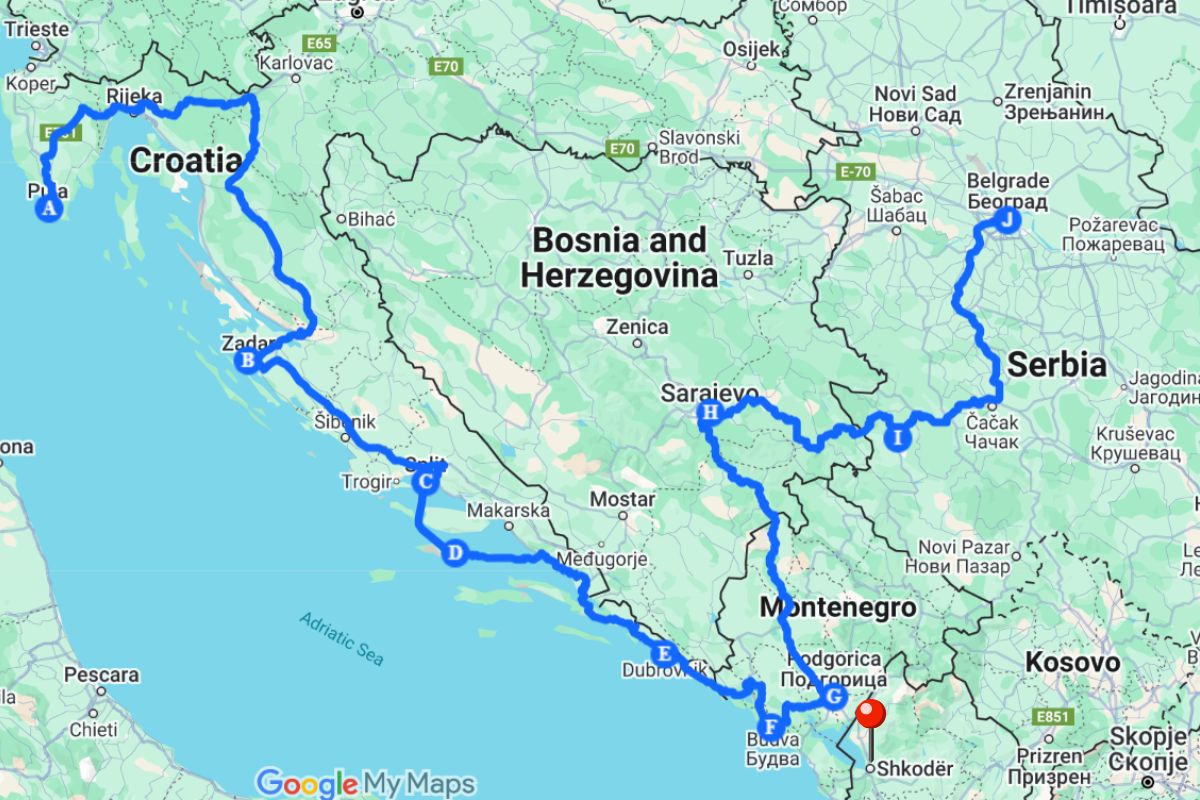
Our favorite places to stay in the Balkans ❤️
Day 1–3: Pula
From Roman ruins to rock and roll.
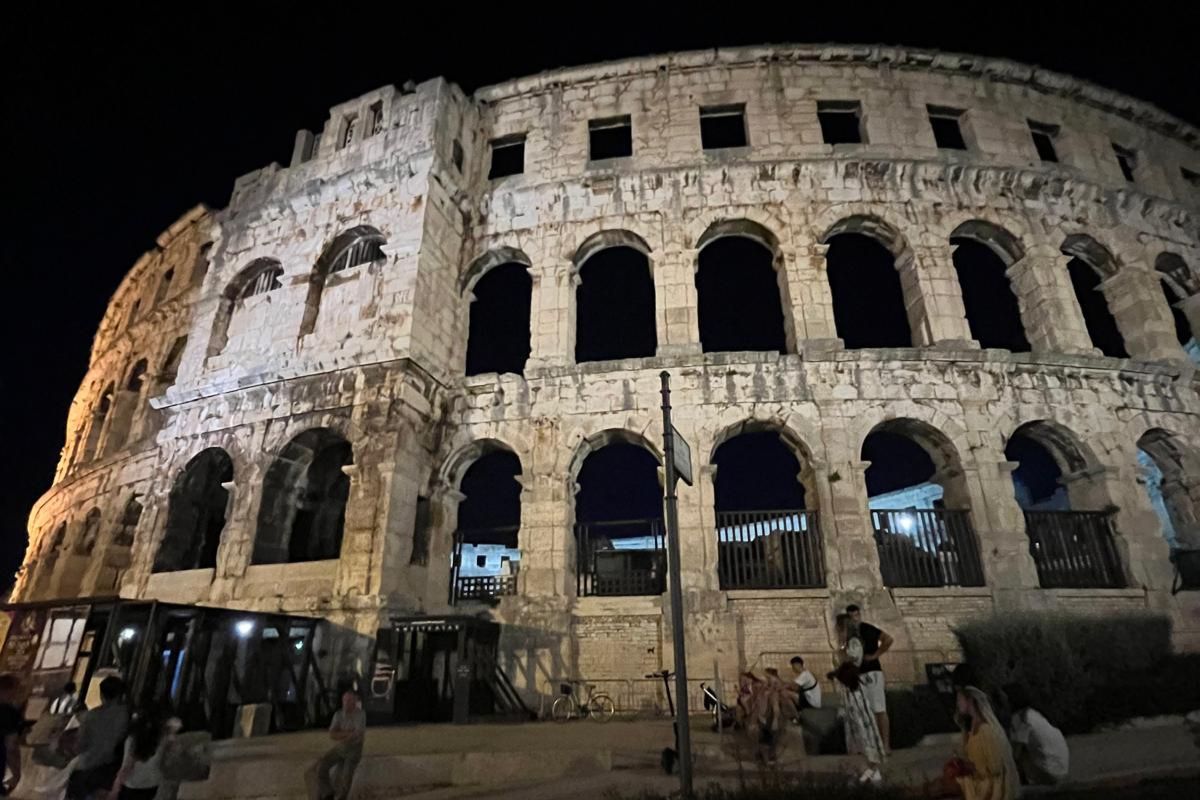
We had no expectations for Pula but we knew it was known for a well preserved Roman Amphitheatre and a chance to get in the Adriatic Sea early on in the trip. Well, there’s two Amphitheatres, and the night we got there, we saw Thievery Corporation live. This is a group we had been listening to on the drive and the location for the concert was magical. The town has a lot of bars and restaurants and a couple of good clubs too. It’s known for being a holiday resort in the region and it makes a logical starting point. Rijeka up the coast is an equal shout. Pick one, you needn’t spend time in both – but do pick one. The Roman Amphitheatres are really well preserved and make Trieste’s ruins look a bit embarrassing.
Best Bits: Roman Amphitheatre, live music and our first dip.
Worst Bits: Accommodation choices are a bit dated.
Getting There: We started our Balkans roadtrip with a 2 hour drive from Trieste, Italy. Map said 90 minutes, but aren’t driving fast. Flixbus follows this route too for about $25. Bus Tickets from Trieste

Day 3–4: Zadar
Where Croatians come to party.
Zadar is a classic Dalmatian coast city. While it’s not as big as Split, it’s also not got as many rough edges. It’s a souvenir image of a Croatian coastal town. The old walls and passageways make for a great bit of cheap exploration – a ‘thing to do for free’ task. I came here a few years back on a Sail Croatia trip and remember it had a kind of beach. It does have a kind of beach, but don’t expect golden sands. I could be wrong here, but I think it’s a reclamation job. We tried to sunbathe without any towels and ended up with grit back. This is up by Kolovare Beach. If you’re here with family or kids, there are pedalos and areas for the little ones to play. It’s a pretty little town with plenty of reason to stop by.
We stayed up by Park Jarula in an apartment which gave us views of the harbour, but there’s also some really good solo traveller hostels too. (Recommended to us was: Boutique Hostel Forum)
Zadar is great if you like a stroll as you can stroll around the perimeter of the town and see the sea nearly every route you take. Peaceful in the day with a raging nightlife if you want it.
Best Bits: Great nightlife and they have a beach of sorts
Worst Bits: Hangovers in the heat
Getting There: The drive here from Pula is around 5 hours when you account for traffic, it’s just shy of 400km. There is a ferry also but it takes the same amount of time. Save your money and hop on Flixbus if you’re travelling without your own car.
Bus tickets: https://www.flixbus.co.uk/bus-routes/pula-zadar.
Day 4–5: Split
We came to…Split.
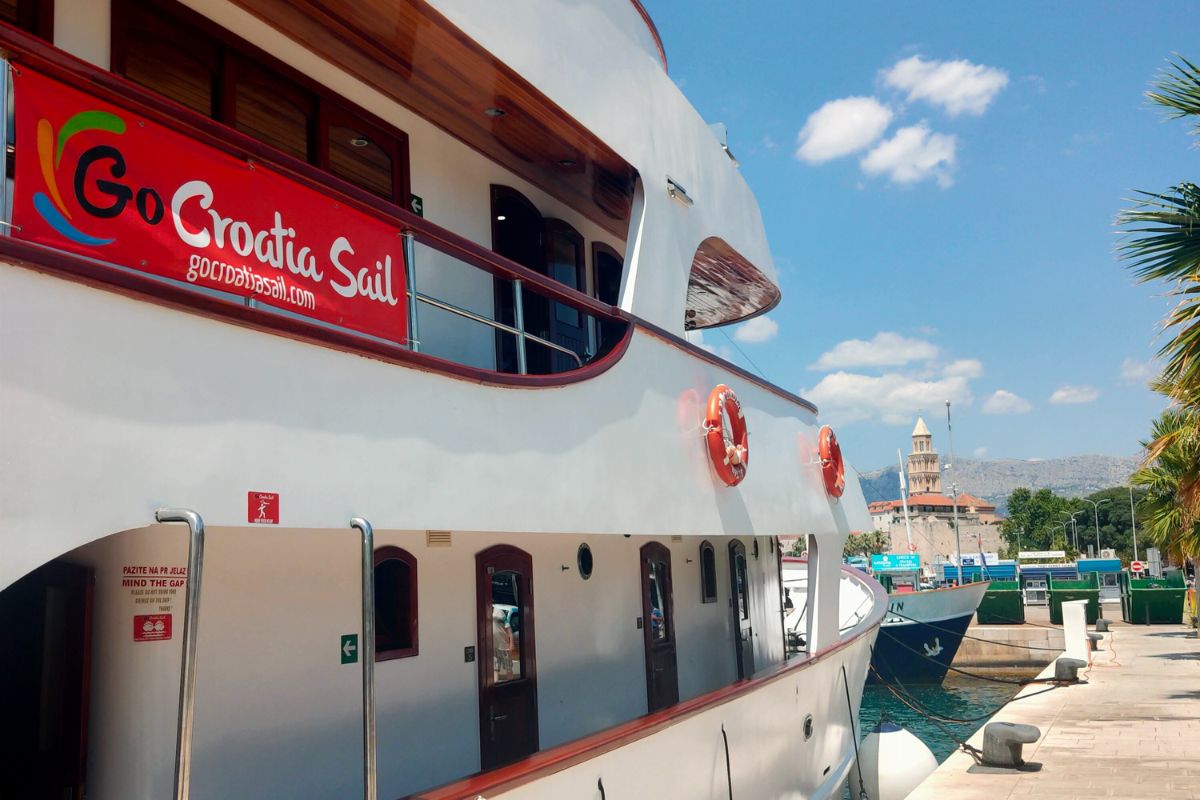
If the only place you came to in Croatia was Split, you can have a lovely weekend break here. It’s great for 48 hours, but it’s quite compact and a central transport hub, so it feels a little bit more manic. There are some lovely restaurants but it’s quite busy and for me Zadar is a prettier version of Split, and I’d already spent time doing the Croatian old towns for a couple of days.
For us, we used Split as a place to travel through to hit Hvar. We found a place to park our car on the edge of town in a long stay, and traipsed the 30 minutes in baking heat with bags back to the harbour. Once there we stood in the sun waiting for our ferry to leave along with about a hundred other backpackers and solo travellers. Note: bring water, sun cream and a hat – you will be glad of it.
We weren’t completely cultureless, we walked around Diocletian’s Palace and drove up to the Klis Fortress, which is known as a location in Game of Thrones. (Mereen).
One other recommendation to research. If you have the time, you should consider booking a day trip up to the Plitvice Lakes National Park. They look every bit as good as the pictures show. In the summer the falls tend to dry up but the lakes are still stunning. They make for good social media content 😉
Best Bits: Great restaurants and has a ferry to Hvar
Worst Bits: I think it’s a messier version of Zadar personally
Getting There: The bus here from Zadar is cheap (£10/$13) and about 90 minutes. By car, it took us 2 hours. Tolls? Don’t think there was any, but if there were, they were in the 1-2 Euro range.
Bus tickets: https://www.flixbus.co.uk/bus-routes/zadar-split.
Day 5–9: Hvar
Boiled egg vending machines
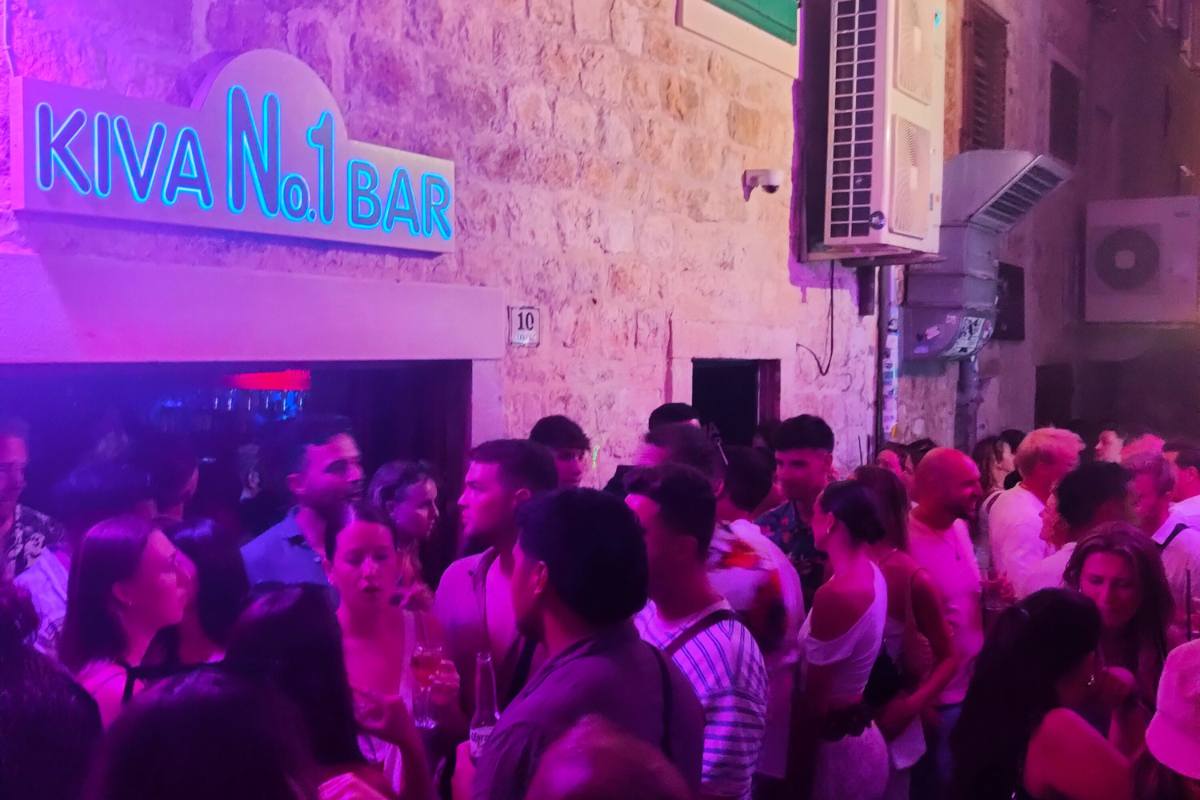
The original intention was to stay here for one night, and then we walked out onto our balcony and saw the most amazing view. We then decided pretty quickly that we were going to extend our trip.
Hvar is lush. It’s more than just the ‘Stari Grad’ the Old Town, it’s got hiking, little villages and beautiful marinas. It’s also loaded with exceptional nightlife…and daylife.
From the beach bars like Hula Hula to the passageway drinking spots such as Kiva on Fabrika; which really are an amalgamam of multiple dive bars, the Old Town goes off. Carpe Diem is the big one, which runs boats across to the moorings over weekend evenings, and the night we missed was when Shaq was allegedly on the decks.
How true that is, I am unsure, but it is a spot in the world which draws in some of the rich and famous. Despite saying that, drinks prices in bars here are still much more affordable than somewhere like ibiza so it’s a great choice for those who like to dance on their travels.
We stayed in a family run guest house-cum-hostel and it was immense. The owner’s uncle, a war veteran, would give us lifts into town and back, he was lovely. Meanwhile for the day time the pool was pretty instagrammable. The table tennis table became Lee’s new passion and to top it off, they actually had a decent set up of gym equipment around the back. Smith Machine, Cable columns, punch bag – all pretty new. We are going back this year and we WILL be staying there again.
Best Bits: Getting lost in the passageways around Kiva Bar, Dela’s Guesthouse and the beach parties.
Worst Bits: The prices in the supermarkets.
Getting There: Leave your car on the mainland (don’t waste your time bringing it with you) and grab the ferry. It was around £20 – $25 with Omio..
Ferry Tickets: https://www.omio.co.uk/ferries/split/hvar-q4mtp
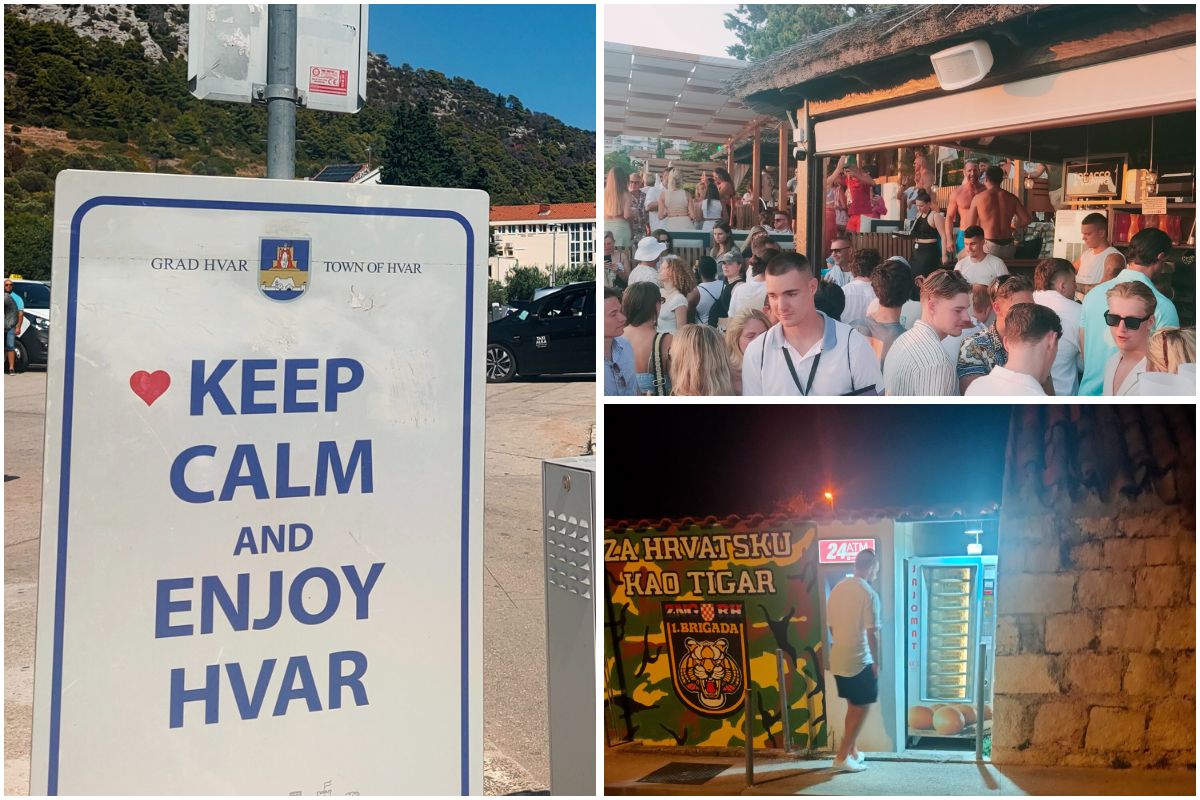
Day 9–11: Dubrovnik
Game of Thrones and shiny floors.
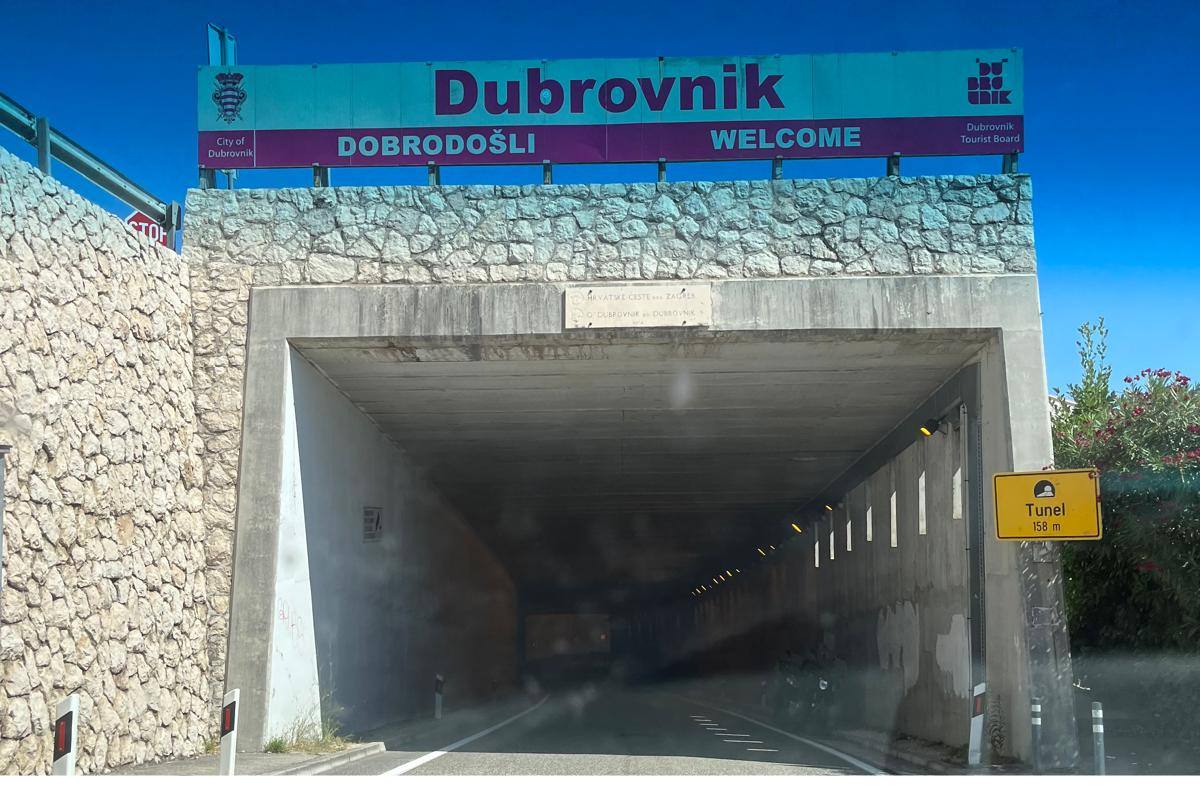
If you’re a GoT fan, this place has become a bit of a pilgrimage, which has meant it’s a bit saturated in peak season. You struggle to move for the other tourists, which feels a bit hypocritical to moan about. Still, it’s a beautiful city with lots of winding walks and it’s steeped in modern as well as Roman history.
Its position out into the Adriatic means it has long been a prized fort city, and after about a week of partying we decided to level up our brain game and took a walking tour of the city, where we saw artillery shell marks on the walls of the old town.
We got here a little late in the day on day 9 so devoted day 10 to walking up to viewpoints for good photo shots; sliding our feet around the polished stones down in the walled city and then headed off early on Day 11. For us the crowds made it a bit overwhelming for what is otherwise a stunning place to stop. It’s a UNESCO World Heritage site for a reason and while you could spend longer here, do the locals a favour – grab your photos and leave.
Best Bits: Walk of shame and the Balkans War history tours.
Worst Bits: Too busy with cruise ship passengers.
Getting There: The drive took 3 hours, but you can grab a coach for about £13 / $16 USD.
Bus tickets: https://www.flixbus.co.uk/bus-routes/split-dubrovnik.

Day 11–12: Budva
A new country!!

Montenegro calling… I’ve always wanted to visit Budva ever since I saw a really nice looking apartment for sale on Rightmove’s overseas property section. The satnav said it was 2 and a half hours away but it took about 4, but much of that was because it was a warm Saturday morning and we weren’t alone in our desire to head to the coast.
The route takes you past Kotor and Tivat, two other equally stoppable places, but my advice is pick one of the three.
Getting down to Budva beach and its own Old Town near the Citadel, requires you to drive down one of the most winding, steep, narrow hairpin roads I’ve ever experienced in my life.
Part exhilarating, part terrifying, part mechanically questionable. Our little motor wasn’t going to love the return route.
Budva gave us time to sunbathe. We hired a beach bed, and strolled around the promenade which is a long stretch linking several different beach communities. You’ve got restaurants, bars, parks and activities for kids all dotted along the way.
It’s a weekend stop for many locals or those up the Croatian coast. Budva attracts a lot of Serbian holidaymakers and Russians, while Tivat appears to be the place that the locals tend to prefer more. We had that on good authority from two taxi drivers and a waitress in Podgorica. Our impression was that Tivat is a bit of a Bougie spot – casinos, fancy hotels etc. Not that Budva is dowdy, it’s just a bit more Tenerife than Monte Carlo.
Driving a bright yellow Nissan Micra around on our 3 week road trip, meant we knew where we would be more welcome!
Best Bits: Fresh fish restaurants on the harbourside.
Worst Bits: Driving out of Budva and up the M2.3 into steep elevation. 1st gear, 2nd gear, 1st gear….
Getting There: It’s usually around 2.5 hours from Dubrovnik by road. Buses run this route too and there is a local airport in Tivat also. Try Flixbus for bus tickets from Dubrovnik.
Bus tickets: https://www.flixbus.co.uk/bus-routes/dubrovnik-budva

Day 12–15: Podgorica
The hidden gem of our trip.
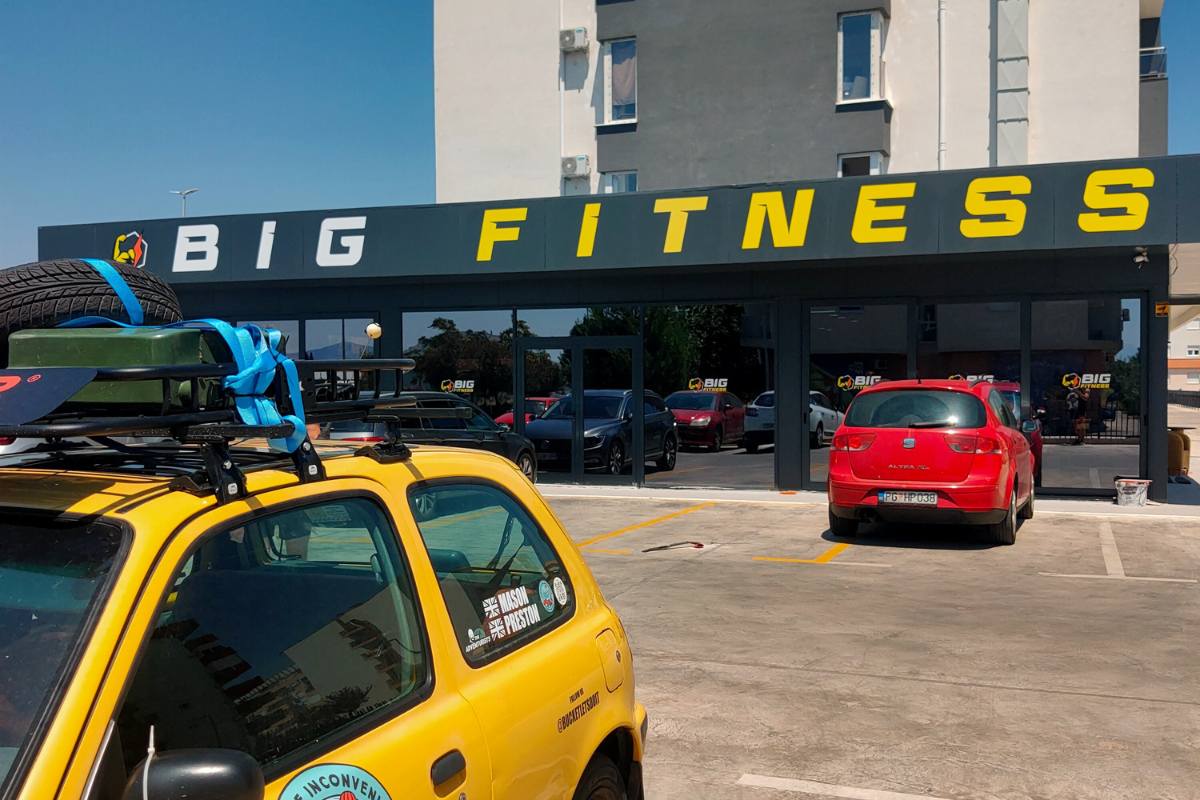
This place is hilarious but we loved it. It’s really central for this part of the Balkans, which means getting to Albania, or North Macedonia is not a great stretch. The prices of everything are like a throwback from before the Euro, even if they take the Euro there. We got a steak at a great restaurant for around £6. You’d pay triple that in the UK, and in the US, you’d pay triple that just for the tip.
For us, we needed a bit of a breather before the final leg. Somewhere to wash clothes, hit the gym, do some work and do some day trips. From here we got out to Lake Skadar and took a drive up to the Waterfalls in Nijagara
We dropped one massive clanger there though. As the picture shows.
Here’s me by the ‘flowing’ waterfalls. Arid.
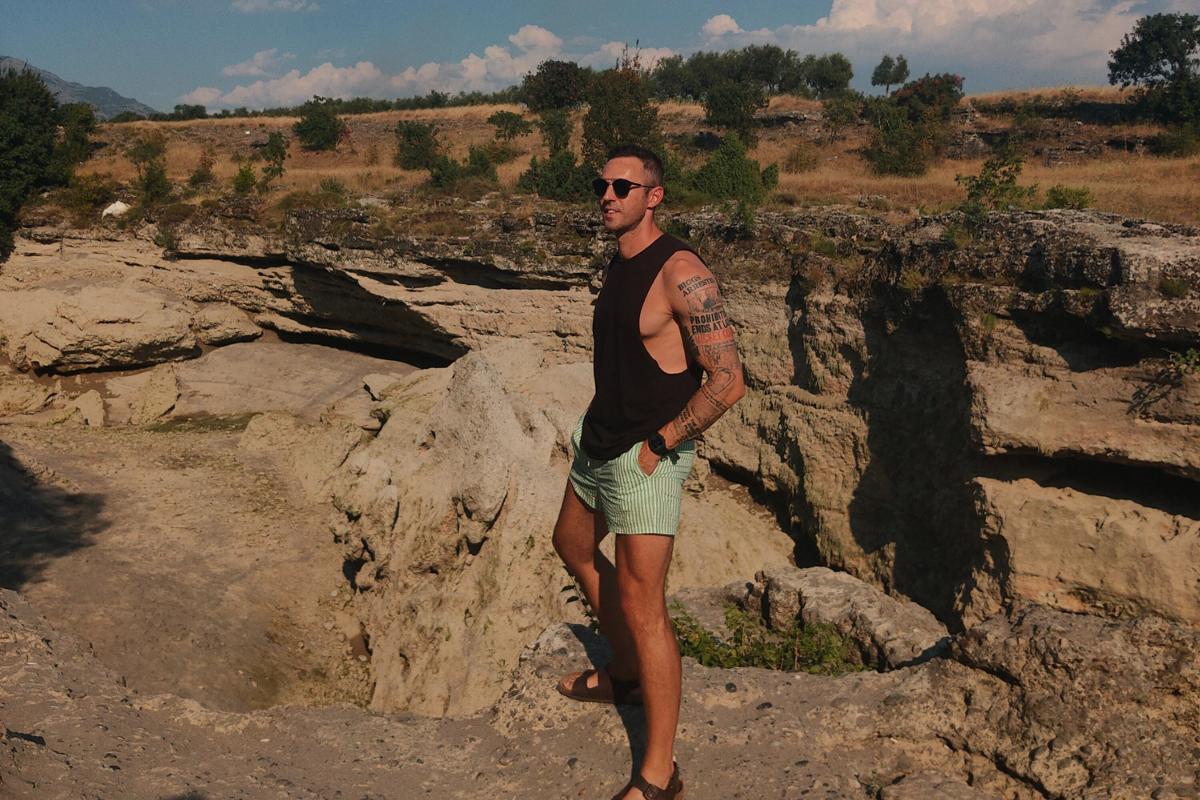
Podgorica is a country that only a couple of decades ago was getting bombed as part of the Nato airstrikes, but at no time did I as a Brit feel unwelcome. Maybe it was the Aussie accent I put on 🙂
The country is working hard to improve its image and infrastructure, from the Millenium bridge we drove over into the city to ongoing road improvement works. It’s a city in progress. You drive down one street and turn into basically a hole. There’s roads that don’t even exist yet – just carnage under wheel. I was a bit concerned the car may lose a tire here but we made it.
Big win for us was the Airbnb – the apartment was 3 beds – massive, with impressive views and set us back about £50/$60 a night. If you’re travelling with someone else, that really helps the budget.
Best Bits: Prices and centrality.
Worse Bits: Roads are smashed to bits.
Getting There: Took us an hour from Budva – buses run the route and for many this is a popular day trip on a warm day. The city can get quite stuffy:
Bus Tickets: https://www.flixbus.co.uk/bus-routes/budva-podgorica
Day 14: Lake Shkodra
A daytrip from Podgorica.
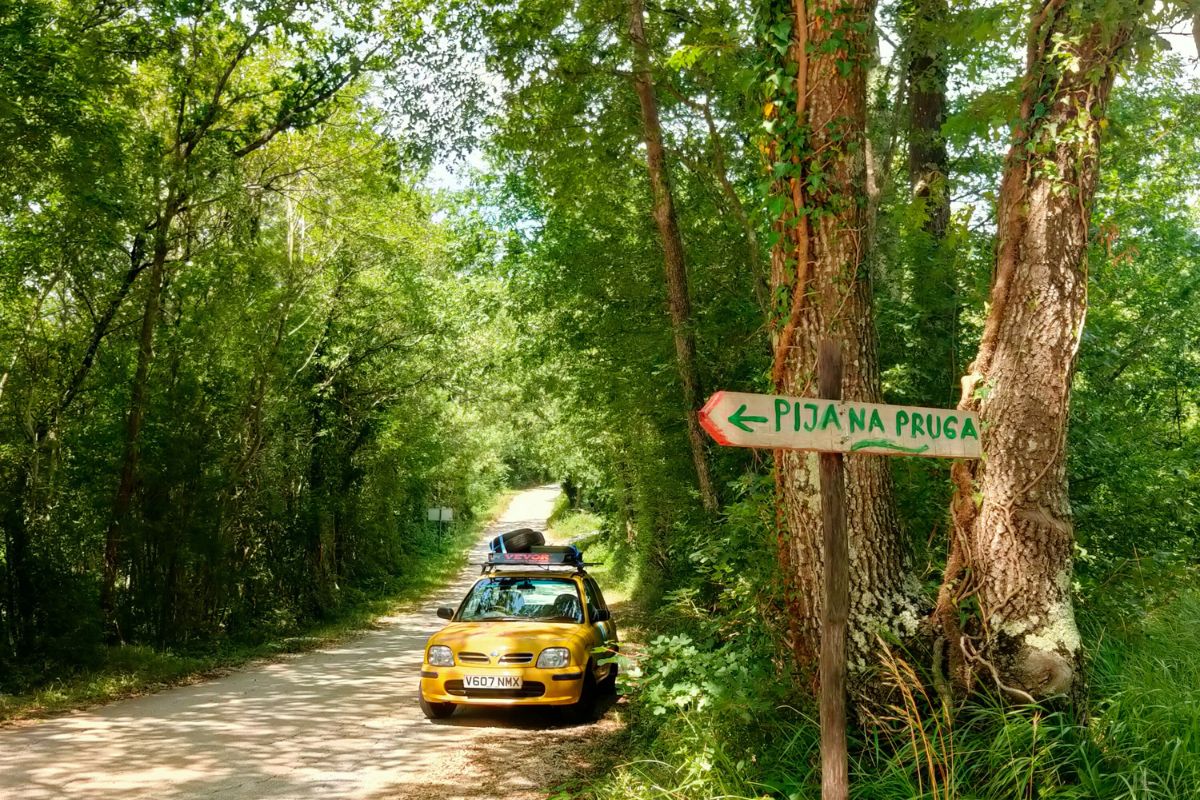
From Podgorica we hopped in the heatmobile for 90 minutes and decided to explore Lake Shkadar on horseback. This for me has been a long time coming. Not exploring Lake Shkadar but getting back on a horse. I’d not ridden since I was a kid and I have been angling to do this for a long time. Lee however had never ridden a horse.
If you have ridden before, certainly in the UK or any country with safety laws, you’ll know that you are told to wear a helmet and heeled shoes.
Welcome to Albania!
Where new riders get to gallop, wear trainers and have absolutely zero protection.
To be fair to the guy, he did a sterling job and hung on, meanwhile I was having the time of my life.
That was also because I could hear my best mate complaining that his horse was broken. Lol.
Midway through the ride, we stopped by the lake and went swimming, had some more Cevapi and just enjoyed the peaceful surroundings of North Albania’s Lake Shkadar shared with its neighbouring countries.
This was hands down my favourite thing to do on this 3 week trip around the Balkans, and as much as I loved Hvar, this is a memory for life.
Who did we ride with? https://adventuroushorseriding.com/
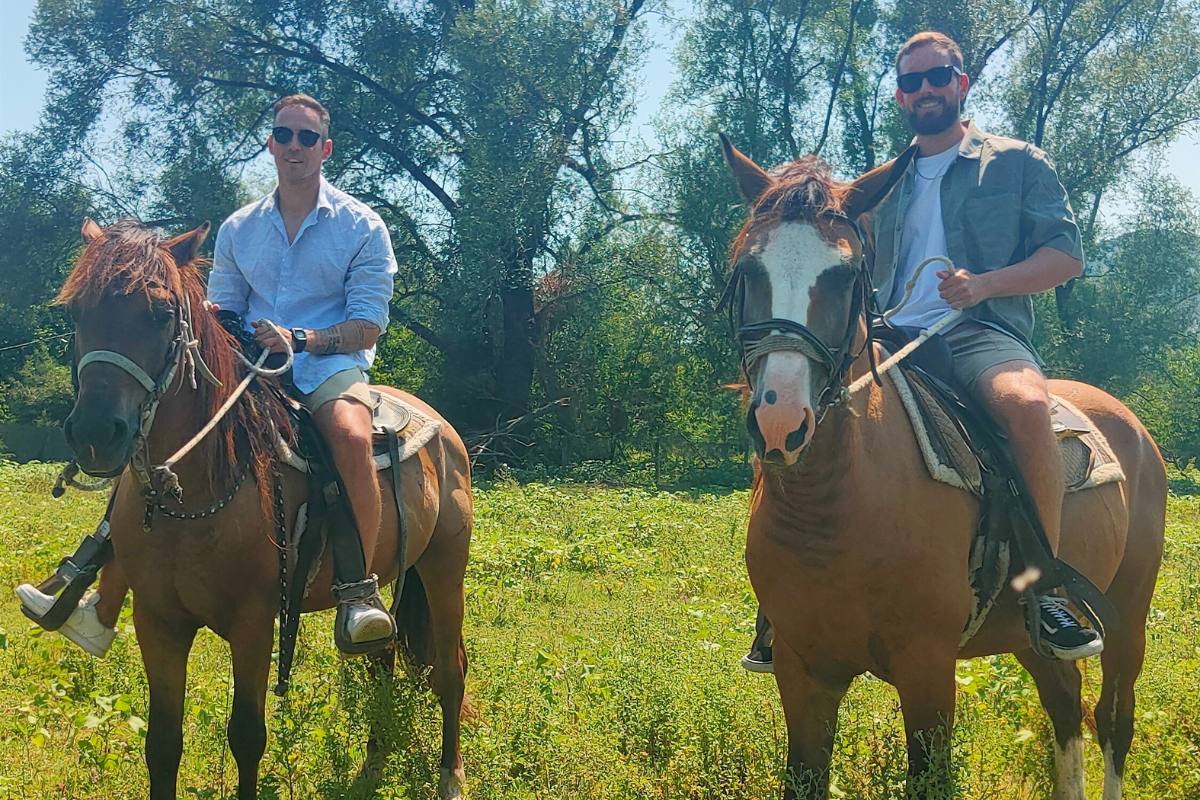
Best Bits: Tranquility and liberty.
Worst Bits: None.
Getting There: 90 minute drive from Podgorica. It’s not really a bus route, but some other operations do pickups and drops off I believe.

Day 15–17: Sarajevo
Roadside watermelon and country no.4.
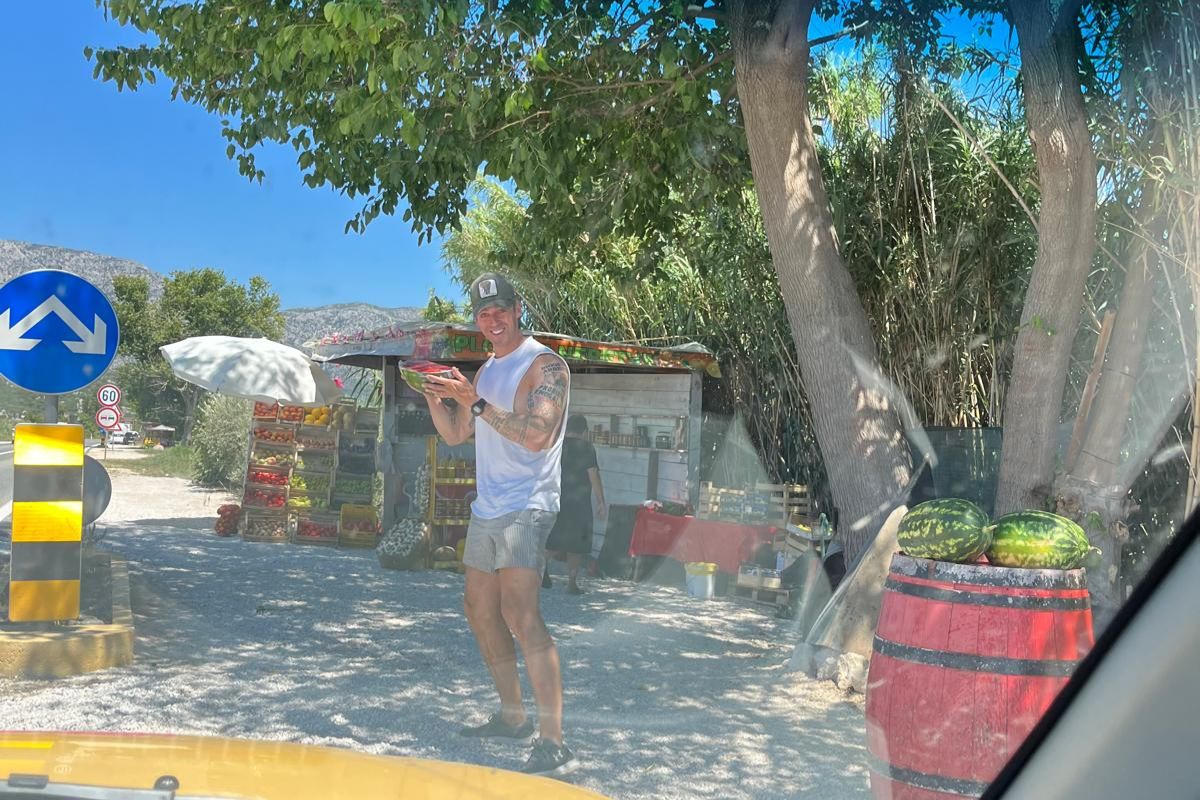
I’m 42, so to me Sarajevo has a strong resonance around the Balkan conflict. It’s culturally different from Serbia and Montenegro as a Muslim nation and the route here takes you past some beautiful minarets as well as pretty stunning roadside scenery.
It was driving through Bosnia where I almost got driven into and the roads are a little less well maintained here. But, if you want to explore the world, you have to head off the beaten track sometimes. The city of Sarajevo still has a lot of its Ottoman influence and is very walkable too. So after getting here late, we found a little restaurant in the hills coming in to eat Gulas and committed ourselves to pairing getting steps and sightseeing on day 16.
We stayed in Bascarsija which is in the centre of town alongside the river Miljacka, which puts you bang slap in the heart of a lot of the local cultural attractions. From the more sombre Museum of Massacre to the sight of WW1 trigger point, Latin Bridge, where Archduke Franz Ferdinand was assassinated.
We stayed at the Hostel Vagabond in this area, one for the location, two for the private rooms and three because it is considered a lot more sociable. There’s an active buzz about the place and it’s pretty easy to get talking to other travellers in the communal lounge area. If you’re travelling alone, that would be my shout.
They host a lot of social events and are active on the Hostelworld app too. Given the nature of the location, it’s a bit more niche, so people are more interested in you as a traveller.
Where we stayed: https://www.hostelworld.com/hostels/p/79685/hostel-vagabond-sarajevo/
On a recommendation we took a walk across the Latin Bridge around early evening to a cafe imaginatively named ‘City View Sarajevo’, and it didn’t disappoint. The views across the city from the south of the river are lush.
Food wise, it was more lighter meal options but for a place to sit and while away a couple of hours it was perfect.
I feel like taking the time to come to Sarajevo is a respectful thing to do if you’re heading around the Balkans. It’s a country that embraces multi-culturalism; and the locals are appreciative of your custom. It felt in some parts, like a mini Istanbul with its Bazaar, minarets and range of other religious buildings.
One word – lovely.
Best Bits: The walkability, the bazaar market and sunset across the city
Worst Bits: Probably a little quiet for some
Getting There: It’s about a 4 hour drive from Podgorica whether by car or coach. No trains run this route. Expect to pay around £25/$32 for a bus ticket on this route.
Bus tickets: https://www.omio.co.uk/coaches/podgorica/sarajevo-7hkm0
Day 17–18: Zlatibor
The ski village without the snow.
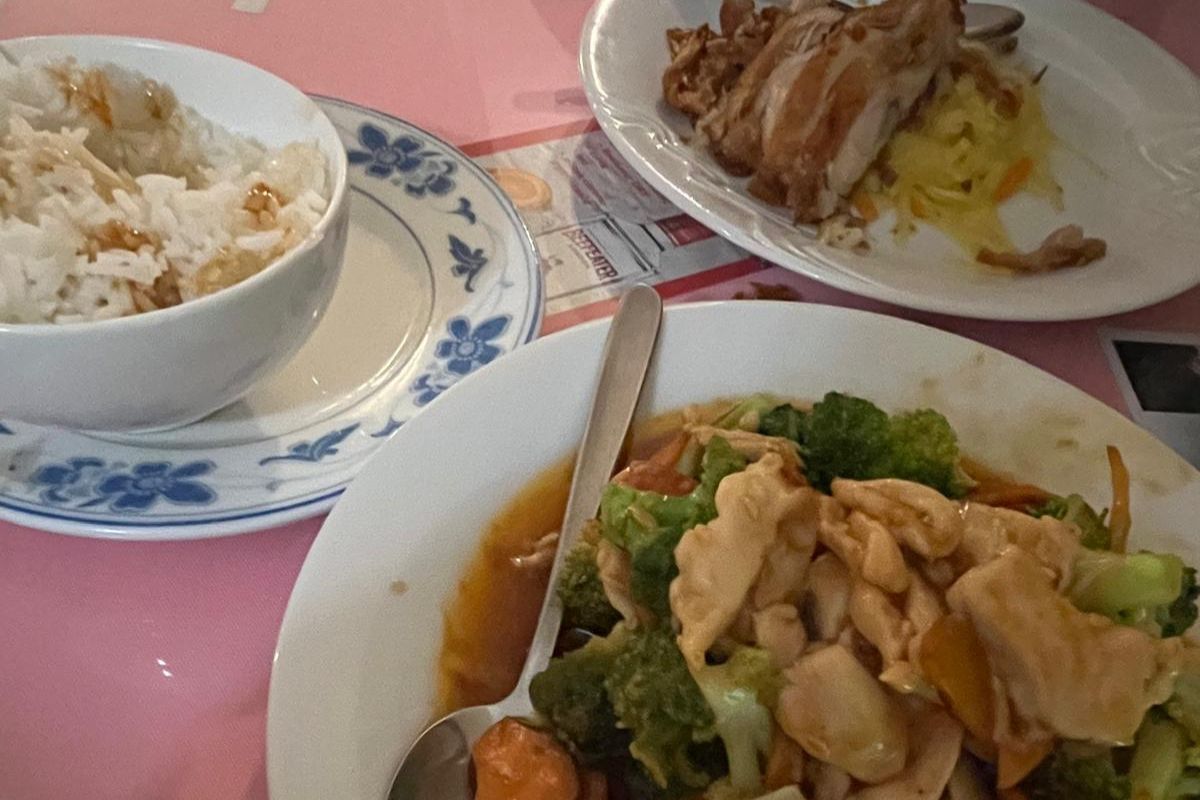
To break up the city streak of Podgorica, Sarajevo then Belgrade we thought we should stop somewhere a little less urban and detoured to Zlatibor. This place is a popular ski resort for Serbians and others in the Balkans. It’s obviously cheaper than heading to the Swiss Alps and out of season there are a lot of nice places to stay, for not a lot of money.
In truth one evening here was sufficient. We checked into our hotel, used the gym, and then went out into the town. Even out of season there were a lot of holidaymakers walking around little foodmarkets and we had seen a recommendation on Tripadvisor for a traditional restaurant so thought we should go see the number 1 place to eat in town. Restoran Bakrač, is one of those places where people stand there and play music at you while you eat, but feels homely, and the food was best described as hearty. If this is traditional Serbian food, I could do this more often. We had Veal rolls, more Gulas and a lot of local beers. The only downside of eating out in much of the Balkans is the fact people still smoke indoors – but that’s not a problem so much for this place, it’s just a cultural fact.
Stuffed and pleased with the price too, we strolled about for a bit and then headed back to our apartment. Being up at a higher altitude did make it a little chilly, and it was here where I finally wore a hoodie. So pack one, just in case.
Where we stayed: https://www.booking.com/hotel/rs/21-century-zlatibor-residences-spa-amp-wellness-by-adora-zlatibor1.en-gb.html
Thoughts? Really nice – a wellness spa, with parking and modern comfortable apartment style hotel suites. Oh and the breakfast was top class. A really decent buffet included in the price.
Best Bits: Eating veal rolls
Worst Bits: Not a lot to do out of ski season
Getting There: It’s a 3 hour trip by car from Sarajevo to Zlatibor. You’re near Tara National Park on the drive, so it’s quite scenic too. Enjoy it.

Day 18–21: Belgrade
Let’s Splav it!
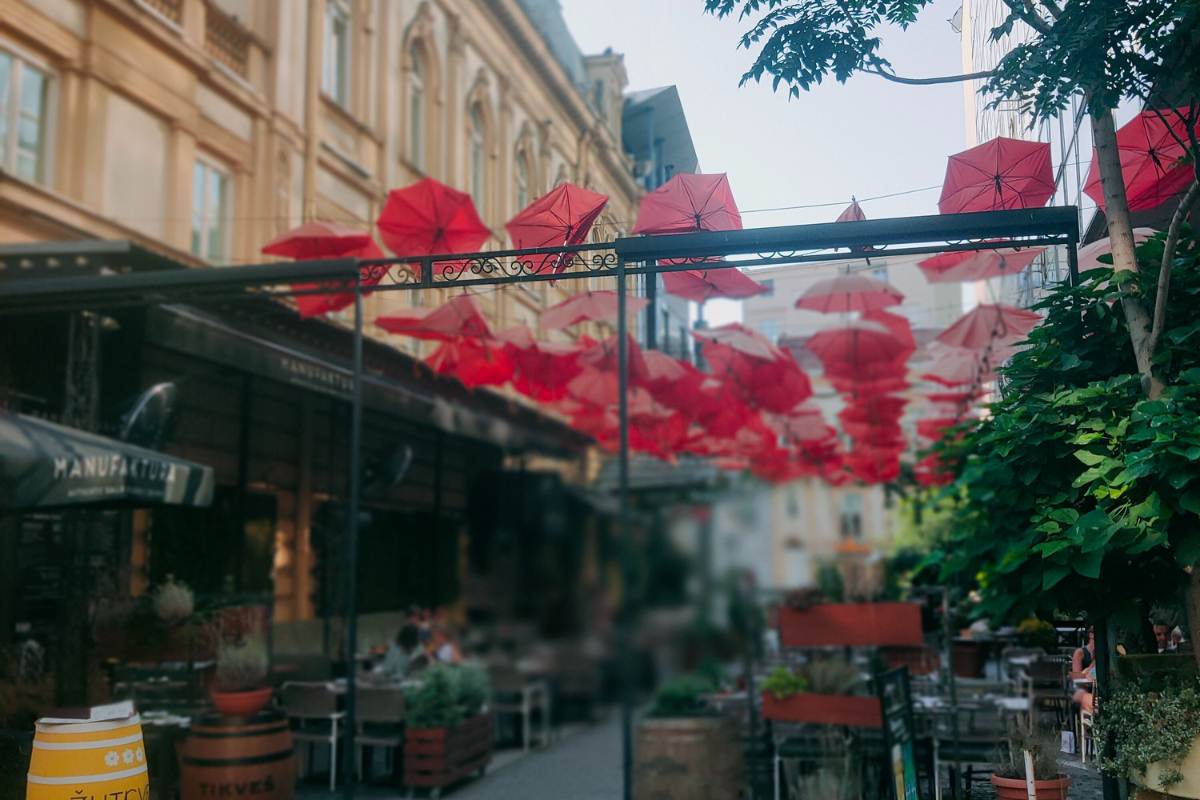
Lee had heard about the party boats of Belgrade, and had wanted to head here from the start. These are what the Navy might call a Stone Frigate. They are mostly lightweight buildings built onto the waters edge, and are dotted along the Sava River. In Serbia they are known as ‘Splavs’.
And yes – we went to one. Money Club. But before that, we did do some genuine normal tourist stuff too.
If you’re driving to Belgrade, understand parking is a nightmare. We found it easier to store our car in long term parking in the city and then just get about by foot each day instead.
Our accommodation was an amazing Airbnb which had a roof terrace that resembled a riad rooftop. Externally the building we stayed in was not much to look at. Like a lot of buildings in Belgrade, they are influenced by the Soviet stylings of the 1950-70s. So, walking in, we didn’t know what to expect. Don’t be put off though, looks can be deceptive. We stayed in the Stari Grad close to the Republic Square, which made all of the key attractions and places to eat pretty accessible on foot. It probably explains why parking was a nightmare too.
Belgrade was earmarked for partying so we took in Skadarlija, for some early evening drinks in the dive bars, before heading off to the castle grounds where we found ourselves in one of the coolest early evening nightlife spots, Boho bar. We landed ourselves a table by ordering some bottles of wine and proceeded to drink ourselves ready for some Splav adventures later.
Much of the evening was pretty hazy but it involved us ending up at a place called Money Club making friends with a lot of randoms who will now forever live in Instagram follower count.
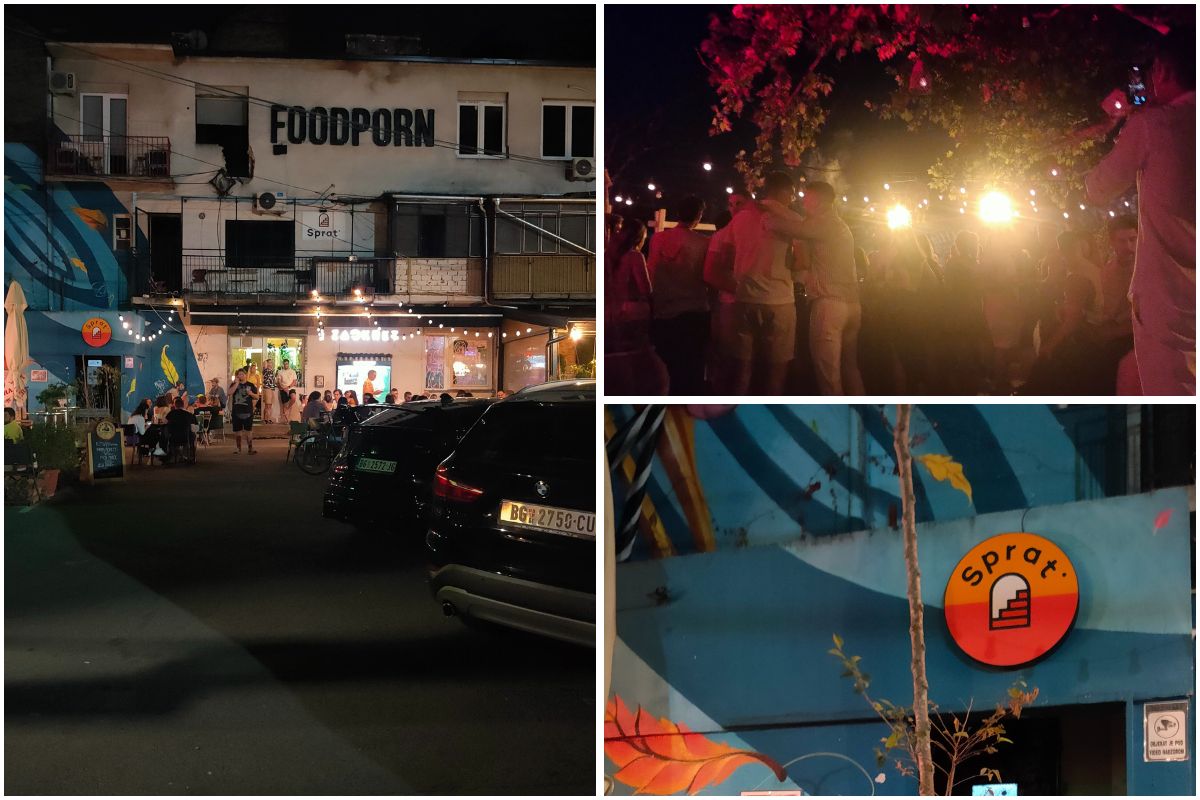
Best Bits: Partying in the castle and outdoor coffee culture.
Worst Bits: Parking
Bonus Tip: Check out the old trams from the communist era, and explore Beograd on foot to see some incredible street art.
Getting There: It took us 3 hours to get here from Zlatibor and being a main city in the region there are buses that make this route too.
Bus tickets: https://www.omio.com/travel/zlatibor/belgrade-nbbji
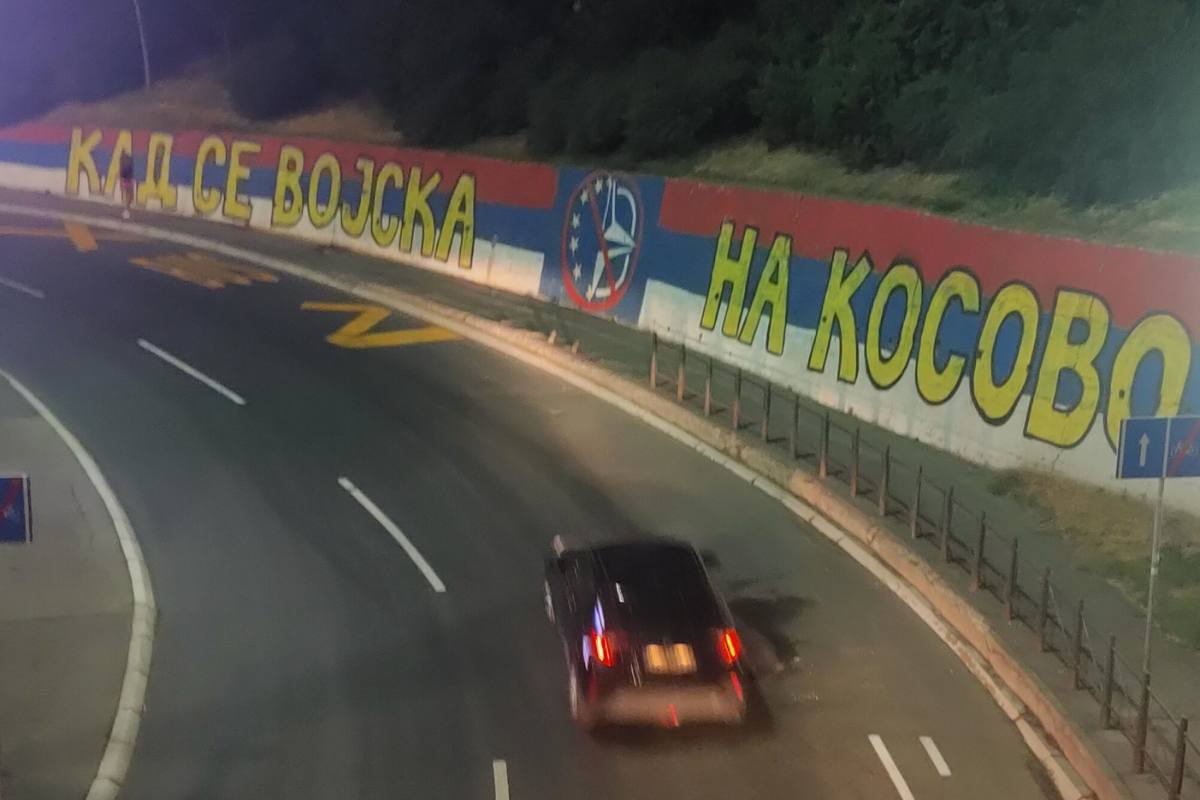
Best Places to Stay in Belgrade
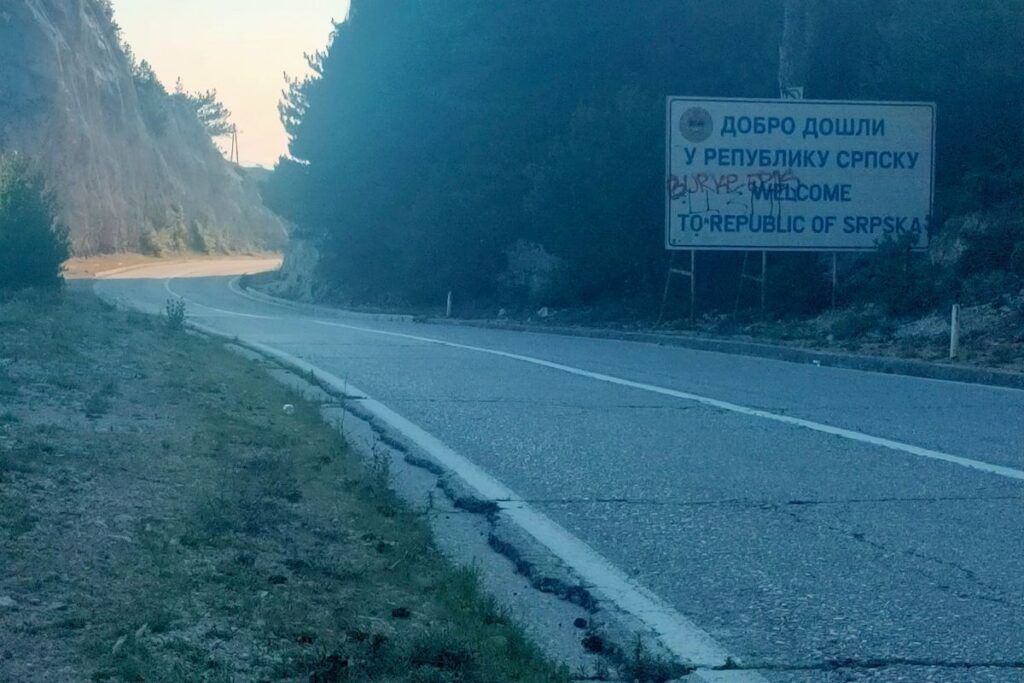
One more itinerary idea
If you prefer to stay in the shade or you’ve already done the stops along the Dalmatian coast before, another route to consider is one that takes a more citywide focus. This is the route we are taking next when we go back to hit Hvar again:
The route
Ljubljana > Zagreb > Belgrade > Skopje > Tirana > Podgorica > Dubrovnik > Sarajevo
- Start with Ljubljana in Slovenia – a pretty city with a lovely riverfront (2 days)
- Next up head to Zagreb the capital city of Croatia (2 days)
- Cut across to Belgrade, a 4 hour drive from Zagreb or 7 hours if you take the scenic route. (Don’t – it’s hilly, so don’t use a car like ours) (3 days)
- From Belgrade take a long drive to the capital of North Macedonia, the historic city of Skopje. (2 days)
- Cut South toward Tirana in Albania, which is an underrated city to party in. This is also a cool city to say you’ve been to. Wild West (2 days)
- Recharge your batteries in Podgorica, Montenegro. Go and visit Budva for the day, or take yourself off to Shkodra to horseride. (3 days)
- Stop in Dubronik for the day and then journey up to Neum, Bosnia’s only coastal access point and nice beach resort. (1-2 days)
- We are going to drive on a bit and sail across to Hvar, before driving inland and getting to Sarajevo via Mostar. (4 days Hvar, 1 night each in Mostar and Sarajevo)
This whole route is a 3 week Balkan itinerary also, giving you time for 24-48 hours in each city. Actually I tell a lie, this route will take not 21 days, but 22 days, still – it’s close enough!
Doing the Balkans this way gets you to every capital city in the region except for Pristina in Kosovo, and if you do want to go there, you will need to go after you’ve been to Serbia. For political reasons, entering and exiting Kosovo is a bit of an aggravation depending on which countries you’ve accessed it first from. Save the headache and do it last or after needing to re-enter Serbia.
More itineraries in this part of the world:
Extra pre-trip info on the Balkans
I think I’ve covered a lot of the essentials on what to think about before doing a 3 week trip around the Balkans, but for that extra level of detail, I’ve put this section together for you.
Travel budget for 3 weeks in the Balkans
This information was collated from a range of open source data providers, such as pricing averages on Hostelworld.com, Booking, and public data from the official tourist boards of Serbia, Croatia, Montenegro, Albania, North Macedonia, Bosnia and Slovenia.
Balkans Trip Cost Calculations
Will my budget stretch? If you need to work out if your planned budget for spending 3 weeks around the Balkans will last the distance, try our trip cost calculator linked below. This will cover you for a 3 week roadtrip or overland bus trip, the numbers are faily similar.
What numbers to use? Use the numbers above, as these are based on backpacking on a budget to a solo traveller doing it in style. The rate for transport per day was what I averaged travelling between cities in Morocco which you can see tended to actually be around £10 per day.
I found that for me, I got around the Balkans in 3 weeks on a budget of £2500-£3000 or $3500-$4000 USD. We did splash out a bit in Hvar, which probably added a fair whack to those numbers. It did help having someone to share the costs of travel with; which is one advantage of a roadtrip vs solo travel here. But all in, if you’re staying in hostel dorms you can budget comfortable for around $70-$75 USD (£62.50) per day, make it more like $100 (£82) if you are sharing private rooms or taking your own.
BUDGETING: 3 Week Trip Cost CalculatorMust-try Balkan Dishes & Drinks
Looking back, I tended to live off an awful lot of Gulas (Goulash) and that’s for three reasons:
- It’s cheap
- It’s fairly healthy
- It tastes good
So, in terms of food recommendations, I would very much have that as something to tick off your menu shortlist. If I remember rightly, there is some debate over who invented it first. Serbia claim it as their own, and Hungarians are mostly known for inventing it. Either way, it’s very prevalent in Serbia, while you tend to find a lot of Italian or Venetian cuisine along the Adriatic coast. Croatian pizzas are every bit as good as Italians personally.
Food
Look out for the following dishes on your travels and give them a try:
- Njeguški stek – This is cheese and prosciutto wrapped in veal loin. It’s massive in Montenegro and part of our meal in Zlatibor, Serbia. A traditional dish and very, very popular.
- Serbian Goulash – A national stew made with slow cooked beef chuck steak, paprika, vegetables and potato. Hearty, and very dunkable with your Lepinja. (Balkan style bread)
- Cevapi – How I’ve not mentioned this before I don’t know. Cevapi is amazing. No 3 weeks in the Balkans itinerary is complete without finding your way to eating this – 15 times.
You’ll find it gets used as a burger bun filling also as well as on its own or with veg. Cevapi is best described as grilled mini lamb kofte kebabs – but it is generally made with ground beef. It tastes great and in Hvar there was a great little spot on the way back to our accommodation after a day/night of heavy beer taste testing. The place is called ‘Fast Food Big Bang‘ and is a popular hidden gem in the old town.
Drinks
There is a wide range of Balkan beers, which offer a more interesting option than conventional multi-national brands, but the area is most famous for Rakija.
Rakija is a fruit/plum style brandy, that can often end up in your hands as a post dinner apperitif, in the same way Ibizan restaurants tend to want to give you Hierbas after a meal. It’s quite sweet and easily moreish, but it’s pretty strong, so, keep it controlled.
How will you do your 21 days in the Balkans?
That’s a wrap on our guide on how to do a 3 week Balkans itinerary. If there is anything I’ve mentioned that you wanted me to personally clarify, don’t hesitate to drop me a message on our instagram, or click on my socials from the author box below.
The Balkan region is a fantastic place to get lost in for a few weeks, and our 21 day roadtrip there left me with more I wanted to see. We are going back again soon to spend a bit longer in Hvar, to cruise down the Danube and to head over to Greece to update our 3 weeks in Greece itinerary. If you do head this way, please tag us in your instagram pics or comment below so we can see how you got on, or what you’d recommend for other travellers too.
Thanks for reading and enjoy your own 3 week Balkans trip.
Click the enlarge button on the top right corner. Credit: map data: Google
NEXT UP: 3 Weeks in Italy






